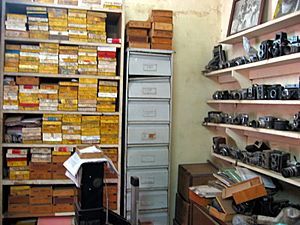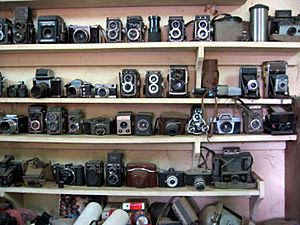Malick Sidibé facts for kids
Quick facts for kids
Malick Sidibé
|
|
|---|---|
| Born | 1935 Soloba, Mali
|
| Died | 14 April 2016 (aged 80–81) Bamako, Mali
|
| Alma mater | Institut National des Arts de Bamako |
| Occupation | Photographer |
Malick Sidibé (1935 – 14 April 2016) was a famous photographer from Mali. He was well-known for his amazing black-and-white photos of everyday life and fun events in the 1960s in Bamako, the capital city.
Malick Sidibé had a long and successful career. He was a very important person in his community in Bamako. In 1994, his photos were shown outside of Mali for the first time. People loved his carefully taken portraits. Since then, Sidibé's work has become famous all over the world.
His photographs have been featured in many books and shown in exhibitions across Europe and the United States. In 2007, he won a special award called the Golden Lion Award for Lifetime Achievement at the Venice Biennale. This was a huge honor because he was the first photographer and the first African person to receive it! He also won other important awards, like the Hasselblad Award for photography.
Sidibé's work is kept in major art collections, including the J. Paul Getty Museum in Los Angeles and the Museum of Modern Art in New York.
Contents
Life and Photography Work
Malick Sidibé was born in a village called Soloba, about 300 kilometers from Bamako, in Mali. His father was a farmer and a skilled hunter. Malick's father wanted him to go to school, but he passed away before Malick could start at age 16.
In 1955, a photographer named Gérard Guillat visited Malick's school. He was looking for a student to help decorate his studio. He ended up hiring Malick Sidibé. Guillat was impressed with Malick's work and took him on as an apprentice. Malick's first jobs were to set up equipment and deliver photos. He quickly learned more about photography by helping Guillat. Soon, he started taking photos for his own clients.
In 1957, Guillat closed his studio. Malick then started taking pictures of the exciting nightlife in Bamako. He became known for his documentary photography, especially focusing on the young people and their culture in the city. He became very famous for his black-and-white photos of popular culture in the 1960s. In the 1970s, Sidibé started to focus more on taking studio portraits.
In 1962, Sidibé opened his own studio in the Bagadadji neighborhood of Bamako. He continued to photograph parties and club gatherings until 1976. He stopped doing "reportage" (taking photos of events) because there were fewer club parties. Also, more people could afford cameras, and it became easier to develop film. Sidibé then focused on black-and-white studio portraits, ID photos, and even fixing broken cameras at his studio.
|
Even though Sidibé was famous in Mali for many years, the rest of the world didn't discover his work until 1994. This happened when he met a French art curator named André Magnin. One of Sidibé's most famous photos from that time is Nuit de Noel, Happy Club (Christmas Eve, Happy Club) (1963). It shows a happy couple dancing. The man wears a suit, and the woman wears a party dress, but she is barefoot. This photo, and others like it, show how Sidibé's photography was closely connected to music. Sidibé often talked about this connection in interviews.
It's interesting that other Malian artists, like the musicians Salif Keita and Ali Farka Touré, also became famous around the same time in the 1990s.
Sidibé used a flash when he was out taking photos at events. But in his studio, he only used tungsten lighting. He used an Agfa 6x6 camera for weddings and formal events. For his more casual photos, he used a Foca Sport 24x36 camera. People said he was a very charming person. He would tell jokes to his clients to make them feel comfortable when he was taking their portraits.
The music video for Janet Jackson's 1997 song "Got 'til It's Gone" was greatly inspired by Malick Sidibé's photography style. The video pays tribute to the 1960s and 1970s, a time that Sidibé's pictures helped to document. This was just after Mali gained its independence from France in 1960. Many people believe that Sidibé captured the joy and wonder of this new era in his photos. More recently, you can see Sidibé's influence in Inna Modja’s 2015 music video for her song "Tombouctou," which was filmed in Sidibé's own photography studio.
In 2006, a film company called Tigerlily Films made a documentary about Sidibé called Dolce Vita Africana. It showed him working in his studio and meeting up with many of his old friends and people he had photographed when he was younger. He also talked about his work in the film.
As mentioned, Sidibé was the first African and the first photographer to win the Golden Lion Award for Lifetime Achievement at the Venice Biennale in 2007.
Malick Sidibé passed away in Bamako due to complications from diabetes. He had 17 children and three wives.
Awards and Recognition
Malick Sidibé received many important awards for his photography:
- 2003: Hasselblad Award for photography
- 2007: Golden Lion Award for Lifetime Achievement, Venice Biennale
- 2008: Infinity Award for Lifetime Achievement, International Center of Photography (ICP), New York
- 2010: World Press Photo award – first prize for single photos in Arts and Entertainment
Collections of His Work

Malick Sidibé's photographs are kept in many public art collections around the world, including:
- Art Institute of Chicago, Chicago, Illinois
- The Contemporary African Art Collection (CAAC) of Jean Pigozzi, Geneva
- J. Paul Getty Museum, Los Angeles, CA
- Museum of Modern Art, New York
- Metropolitan Museum of Art, New York
- San Francisco Museum of Modern Art, San Francisco
- Baltimore Museum of Art, Baltimore, MD
- Birmingham Museum of Art, Birmingham, AL
- Studio Museum in Harlem (New York)
- High Museum of Art, Atlanta, GA
- International Center of Photography, New York
- Moderna Museet, Stockholm
- The Museum of Fine Arts, Houston, Houston, Texas
Exhibitions of His Photos
Malick Sidibé's work has been shown in many art exhibitions. Here are some of his solo shows and group exhibitions:
Solo Exhibitions
- 1995: Malick Sidibé: Bamako 1962–1976, Fondation Cartier pour l'Art Contemporain, Paris
- 1999: Museum of Contemporary Art, Chicago, IL
- 2001: Stedelijk Museum Amsterdam, Netherlands
- 2005: Photographs: 1960–2004, Jack Shainman Gallery, New York, USA
- 2017: Malick Sidibé. The Eye of Modern Mali, Somerset House, London (his first solo exhibition in the UK)
Group Exhibitions and Festivals
- 1995: Seydou Keita & Malick Sidibe: Photographs From Mali, Fruitmarket Gallery, Edinburgh, Scotland
- 2001–2003: You look beautiful like that: The Portrait of Photographs of Seydou Keïta and Malick Sidibé, Harvard Art Museums, Cambridge, MA; and other locations.
- 2004: Photography: Inaugural Installation, Museum of Modern Art (MoMA), New York, USA
- 2007: Why Africa? (featuring Sidibé and other photographers), Pinacoteca Giovanni e Marella Agnelli, Turin, Italy.
- 2015: Making Africa. Un Continente De Diseño Contemporáneo, Guggenheim Museum Bilbao, Bilbao, Spain
Films About Malick Sidibé
Several films have been made about Malick Sidibé and his amazing work:
- Malick Sidibé: portrait of the artist as a portraitist (2006). This film was directed by Susan Vogel.
- Dolce Vita Africana (2008, Tigerlily Films). This documentary was directed by Cosima Spender. It tells Malian history through the people Sidibé photographed. It was even shown on BBC Four!
- Malick Sidibé, le Partage (2013). This film was made by Thomas Glaser.
See also
 In Spanish: Malick Sidibé para niños
In Spanish: Malick Sidibé para niños


